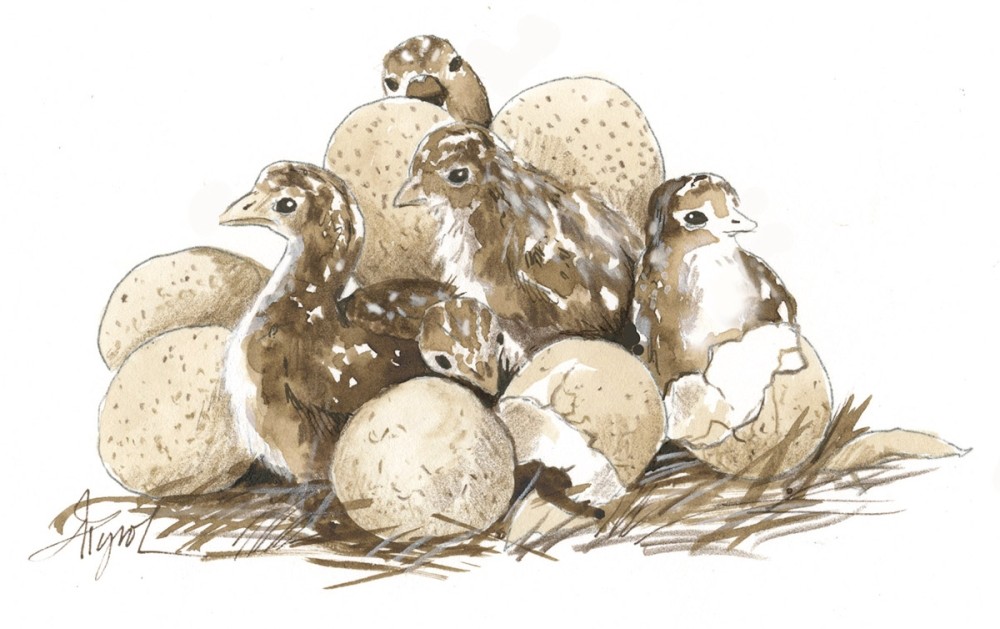
Last June I was walking through our field when I flushed a wild turkey hen. She emerged from the raspberry patch just a few feet away from me. I parted the thorny canes to reveal a nest on the ground lined with dried grass and containing nine large, creamy eggs, speckled with brown. Since we were planning to have the field mown to control invasive wild chervil, I set stakes topped with orange flagging near the nest. The man we had hired to mow was a turkey hunter, and he was happy to give the nest a wide berth.
The hen returned to her nest, and in the following weeks, as I worked in the vegetable garden nearby, I could make out her brown figure through the brambles as she sat on the nest. This hen had mated with a strutting tom turkey in May (one of several females to mate with the polygamous gobbler). But she made the nest and incubated the eggs for almost a month alone.
Most turkey nests are in the woods, but within 100 feet of an opening such as a woods road, clearing, or field. The hen looks for a concealed spot with overhead cover from which she can easily watch for predators. Typical locations are depressions in thickets or beneath the branches of fallen trees.
Our hen had visited her nest each day to lay one egg until she had a full clutch of nine. She probably was a younger hen, as older hens will lay 13 or more eggs. Now she would stay on the nest day and night for 28 days to incubate the eggs, only taking a brief break mid-day to feed on protein-rich insects.
According to the Wild Turkey Federation, only 10 to 40 percent of turkey nests hatch successfully. Ground nests are very vulnerable to predators; raccoons, skunks, foxes, snakes, and many other animals have a taste for eggs. Our dog loves eggs too, so I kept him on a leash when walking past the raspberry patch. The hen would freeze on the nest when we walked by.
After a month of seeing the hen regularly, I checked the nest. She was gone, and the nest was full of opened shells. The young must have hatched!
I imagined our hen feeling something stir beneath her breast – a chick using its eggtooth to break out of the shell. As the downy chicks hatched, the hen would have brooded them under her wings, keeping them warm. After letting the chicks recover for a day, she’d check for predators, then lead the chicks away from the nest, into the pasture beyond, digging up insects for them to eat along the way. Turkey poults are “precocial,” which means they are well-developed and able to walk soon after hatching. Though the chicks weigh only 1.6 ounces when they hatch, they gain 1.1 pounds per month, said Vermont Department of Fish and Wildlife biologist Chris Bernier. By summer’s end, they usually weigh several pounds.
The hen would have eventually led her brood to an open woodland with overhead protection, but one that wasn’t too thick for them to navigate. At night she would have sheltered them under her broad wings. After 8 to 10 days, the poults would have begun to grow their first flight feathers, and by two weeks of age they’d be able to fly short distances to low branches to roost. Soon their down would be replaced by juvenile plumage, which offers better protection from bad weather. They would undergo two more molts before their first winter, and as adults they’d have 5,000 to 6,000 feathers.
During the first four weeks of life, turkeys are very susceptible to weather and predators. Prolonged cold, rainy weather can kill them. A whole host of predators, including hawks and bobcats, will hunt them. Only 25 percent of poults make it past their first month.
Throughout the summer, our young turkeys would have followed their mother, scratching in the leaf litter of the woods for tree seeds and catching grasshoppers and other insects in the pastures. By August they would have been able to fly to the treetops to escape danger and to roost. In the fall and winter, the family would join other hens with their broods. They would stay with their mother until the spring mating season.
One day in early November, after we’d received a few inches of snow, a group of four juvenile turkeys marched up our driveway. We watched through the window as they fed on green grass where the snow had melted on the south side of our barn. Then they continued behind the house toward the raspberry patch. There’s a good chance they were the turkeys that were born there.


Discussion *